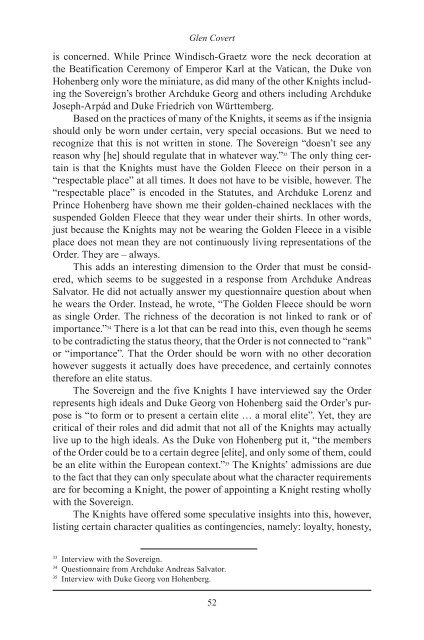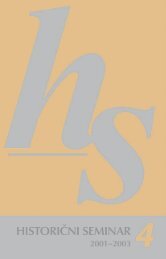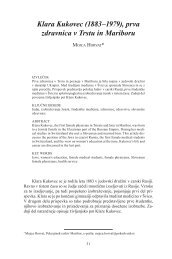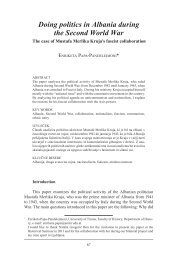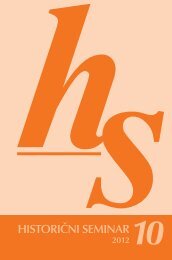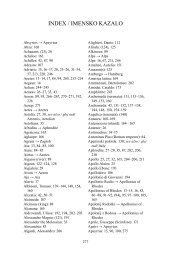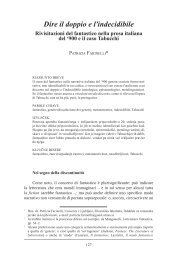The Habsburg Most Illustrious Order of the Golden Fleece: Its ...
The Habsburg Most Illustrious Order of the Golden Fleece: Its ...
The Habsburg Most Illustrious Order of the Golden Fleece: Its ...
Create successful ePaper yourself
Turn your PDF publications into a flip-book with our unique Google optimized e-Paper software.
Glen Covert<br />
is concerned. While Prince Windisch-Graetz wore <strong>the</strong> neck decoration at<br />
<strong>the</strong> Beatification Ceremony <strong>of</strong> Emperor Karl at <strong>the</strong> Vatican, <strong>the</strong> Duke von<br />
Hohenberg only wore <strong>the</strong> miniature, as did many <strong>of</strong> <strong>the</strong> o<strong>the</strong>r Knights including<br />
<strong>the</strong> Sovereign’s bro<strong>the</strong>r Archduke Georg and o<strong>the</strong>rs including Archduke<br />
Joseph-Arpád and Duke Friedrich von Württemberg.<br />
Based on <strong>the</strong> practices <strong>of</strong> many <strong>of</strong> <strong>the</strong> Knights, it seems as if <strong>the</strong> insignia<br />
should only be worn under certain, very special occasions. But we need to<br />
recognize that this is not written in stone. <strong>The</strong> Sovereign “doesn’t see any<br />
reason why [he] should regulate that in whatever way.” 33 <strong>The</strong> only thing certain<br />
is that <strong>the</strong> Knights must have <strong>the</strong> <strong>Golden</strong> <strong>Fleece</strong> on <strong>the</strong>ir person in a<br />
“respectable place” at all times. It does not have to be visible, however. <strong>The</strong><br />
“respectable place” is encoded in <strong>the</strong> Statutes, and Archduke Lorenz and<br />
Prince Hohenberg have shown me <strong>the</strong>ir golden-chained necklaces with <strong>the</strong><br />
suspended <strong>Golden</strong> <strong>Fleece</strong> that <strong>the</strong>y wear under <strong>the</strong>ir shirts. In o<strong>the</strong>r words,<br />
just because <strong>the</strong> Knights may not be wearing <strong>the</strong> <strong>Golden</strong> <strong>Fleece</strong> in a visible<br />
place does not mean <strong>the</strong>y are not continuously living representations <strong>of</strong> <strong>the</strong><br />
<strong>Order</strong>. <strong>The</strong>y are – always.<br />
This adds an interesting dimension to <strong>the</strong> <strong>Order</strong> that must be considered,<br />
which seems to be suggested in a response from Archduke Andreas<br />
Salvator. He did not actually answer my questionnaire question about when<br />
he wears <strong>the</strong> <strong>Order</strong>. Instead, he wrote, “<strong>The</strong> <strong>Golden</strong> <strong>Fleece</strong> should be worn<br />
as single <strong>Order</strong>. <strong>The</strong> richness <strong>of</strong> <strong>the</strong> decoration is not linked to rank or <strong>of</strong><br />
importance.” 34 <strong>The</strong>re is a lot that can be read into this, even though he seems<br />
to be contradicting <strong>the</strong> status <strong>the</strong>ory, that <strong>the</strong> <strong>Order</strong> is not connected to “rank”<br />
or “importance”. That <strong>the</strong> <strong>Order</strong> should be worn with no o<strong>the</strong>r decoration<br />
however suggests it actually does have precedence, and certainly connotes<br />
<strong>the</strong>refore an elite status.<br />
<strong>The</strong> Sovereign and <strong>the</strong> five Knights I have interviewed say <strong>the</strong> <strong>Order</strong><br />
represents high ideals and Duke Georg von Hohenberg said <strong>the</strong> <strong>Order</strong>’s purpose<br />
is “to form or to present a certain elite … a moral elite”. Yet, <strong>the</strong>y are<br />
critical <strong>of</strong> <strong>the</strong>ir roles and did admit that not all <strong>of</strong> <strong>the</strong> Knights may actually<br />
live up to <strong>the</strong> high ideals. As <strong>the</strong> Duke von Hohenberg put it, “<strong>the</strong> members<br />
<strong>of</strong> <strong>the</strong> <strong>Order</strong> could be to a certain degree [elite], and only some <strong>of</strong> <strong>the</strong>m, could<br />
be an elite within <strong>the</strong> European context.” 35 <strong>The</strong> Knights’ admissions are due<br />
to <strong>the</strong> fact that <strong>the</strong>y can only speculate about what <strong>the</strong> character requirements<br />
are for becoming a Knight, <strong>the</strong> power <strong>of</strong> appointing a Knight resting wholly<br />
with <strong>the</strong> Sovereign.<br />
<strong>The</strong> Knights have <strong>of</strong>fered some speculative insights into this, however,<br />
listing certain character qualities as contingencies, namely: loyalty, honesty,<br />
33 Interview with <strong>the</strong> Sovereign.<br />
34 Questionnaire from Archduke Andreas Salvator.<br />
35 Interview with Duke Georg von Hohenberg.<br />
52


